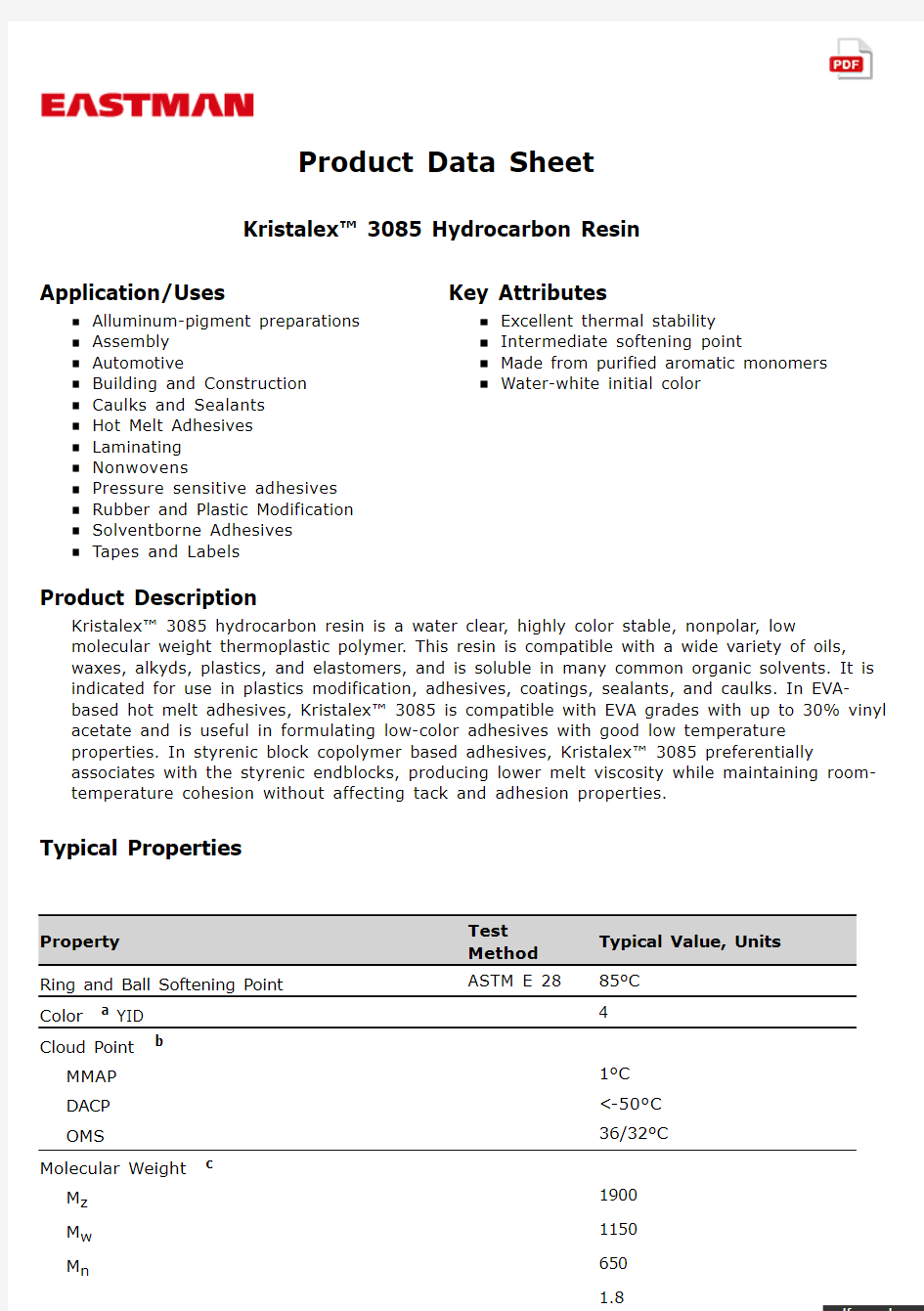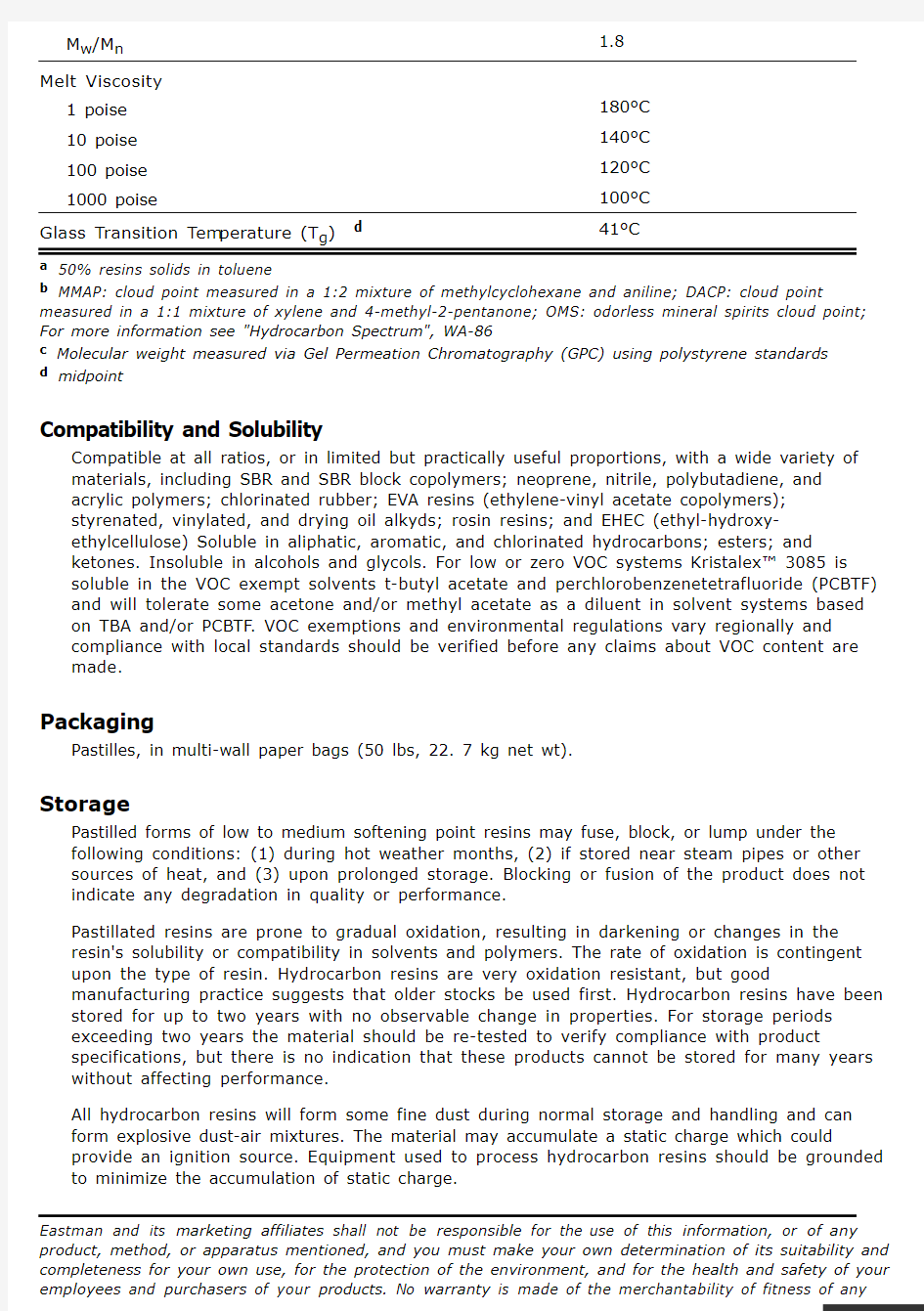伊士曼纯单体树脂Kristalex 3085


Product Data Sheet Kristalex? 3085 Hydrocarbon Resin
Application/Uses
Alluminum-pigment preparations
Assembly
Automotive
Building and Construction
Caulks and Sealants
Hot Melt Adhesives
Laminating
Nonwovens
Pressure sensitive adhesives
Rubber and Plastic Modification
Solventborne Adhesives
Tapes and Labels Key Attributes
Excellent thermal stability
Intermediate softening point
Made from purified aromatic monomers
Water-white initial color
Product Description
Kristalex? 3085 hydrocarbon resin is a water clear, highly color stable, nonpolar, low
molecular weight thermoplastic polymer. This resin is compatible with a wide variety of oils, waxes, alkyds, plastics, and elastomers, and is soluble in many common organic solvents. It is indicated for use in plastics modification, adhesives, coatings, sealants, and caulks. In EVA-based hot melt adhesives, Kristalex? 3085 is compatible with EVA grades with up to 30% vinyl acetate and is useful in formulating low-color adhesives with good low temperature
properties. In styrenic block copolymer based adhesives, Kristalex? 3085 preferentially
associates with the styrenic endblocks, producing lower melt viscosity while maintaining room-temperature cohesion without affecting tack and adhesion properties.
Typical Properties
Property Test
Method
Typical Value, Units
Ring and Ball Softening Point ASTM E 28 85°C Color a YID 4 Cloud Point b
MMAP1°C
DACP<-50°C OMS36/32°C Molecular Weight c
M z1900 M w1150 M n650
M w/M n 1.8
Melt Viscosity
1 poise180°C
10 poise140°C
100 poise120°C
1000 poise100°C
Glass Transition Tem perature (T g) d41°C
a50% resins solids in toluene
b MMAP: cloud point measured in a 1:2 mixture of methylcyclohexane and aniline; DACP: cloud point measured in a 1:1 mixture of xylene and 4-methyl-2-pentanone; OMS: odorless mineral spirits cloud point; For more information see "Hydrocarbon Spectrum", WA-86
c Molecular weight measure
d via Gel Permeation Chromatography (GPC) using polystyren
e standards
d midpoint
Compatibility and Solubility
Compatible at all ratios, or in limited but practically useful proportions, with a wide variety of materials, including SBR and SBR block copolymers; neoprene, nitrile, polybutadiene, and
acrylic polymers; chlorinated rubber; EVA resins (ethylene-vinyl acetate copolymers);
styrenated, vinylated, and drying oil alkyds; rosin resins; and EHEC (ethyl-hydroxy-
ethylcellulose) Soluble in aliphatic, aromatic, and chlorinated hydrocarbons; esters; and
ketones. Insoluble in alcohols and glycols. For low or zero VOC systems Kristalex? 3085 is soluble in the VOC exempt solvents t-butyl acetate and perchlorobenzenetetrafluoride (PCBTF) and will tolerate some acetone and/or methyl acetate as a diluent in solvent systems based on TBA and/or PCBTF. VOC exemptions and environmental regulations vary regionally and compliance with local standards should be verified before any claims about VOC content are made.
Packaging
Pastilles, in multi-wall paper bags (50 lbs, 22. 7 kg net wt).
Storage
Pastilled forms of low to medium softening point resins may fuse, block, or lump under the following conditions: (1) during hot weather months, (2) if stored near steam pipes or other sources of heat, and (3) upon prolonged storage. Blocking or fusion of the product does not indicate any degradation in quality or performance.
Pastillated resins are prone to gradual oxidation, resulting in darkening or changes in the resin's solubility or compatibility in solvents and polymers. The rate of oxidation is contingent upon the type of resin. Hydrocarbon resins are very oxidation resistant, but good
manufacturing practice suggests that older stocks be used first. Hydrocarbon resins have been stored for up to two years with no observable change in properties. For storage periods
exceeding two years the material should be re-tested to verify compliance with product
specifications, but there is no indication that these products cannot be stored for many years without affecting performance.
All hydrocarbon resins will form some fine dust during normal storage and handling and can form explosive dust-air mixtures. The material may accumulate a static charge which could provide an ignition source. Equipment used to process hydrocarbon resins should be grounded to minimize the accumulation of static charge.
Eastman and its marketing affiliates shall not be responsible for the use of this information, or of any product, method, or apparatus mentioned, and you must make your own determination of its suitability and completeness for your own use, for the protection of the environment, and for the health and safety of your employees and purchasers of your products. No warranty is made of the merchantability of fitness of any
product, and nothing herein waives any of the Seller's conditions of sale.
21-Aug-2006 8:58:07 AM
